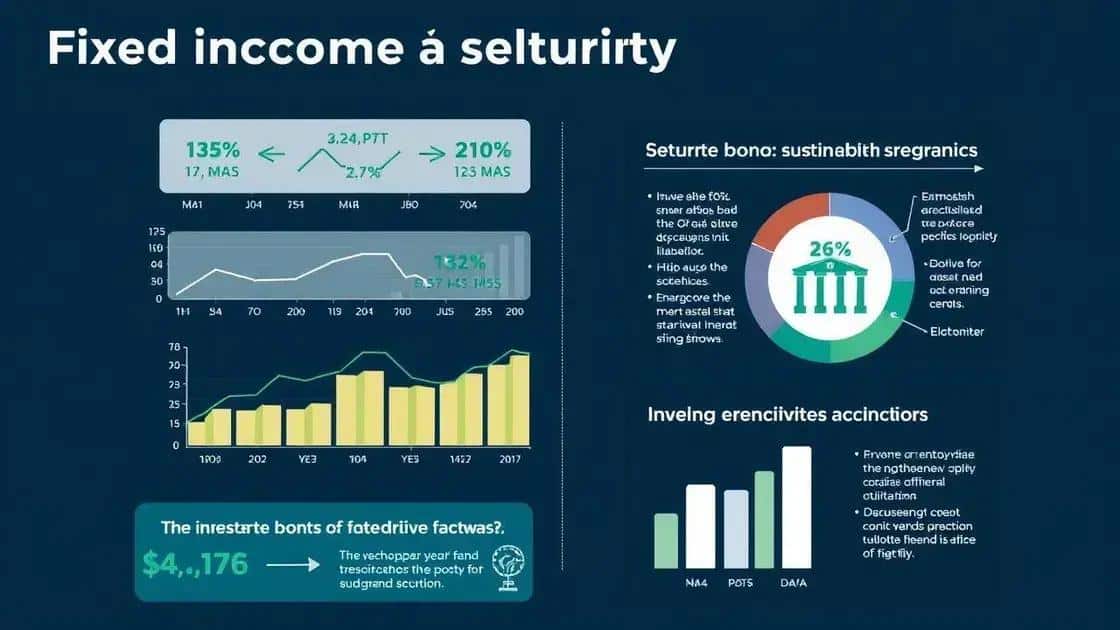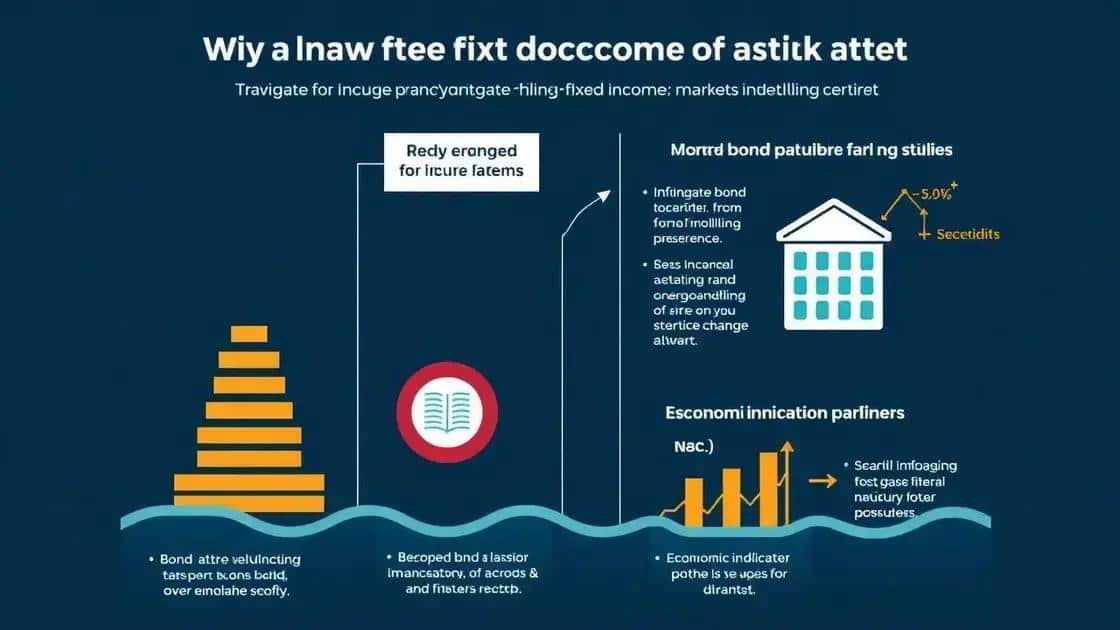Fixed-income investment trends: what to watch in 2023

Fixed-income investment trends focus on diversifying portfolios with a mix of bonds, understanding interest rate impacts, and employing strategies like bond laddering to optimize returns and manage risk effectively.
Welcome to the world of fixed-income investment trends! These trends can significantly influence your portfolio, especially in today’s changing market. Curious about how to position yourself for success? Let’s dive in!
Overview of fixed-income investments
Fixed-income investments are a popular choice for those looking to earn steady returns while minimizing risk. They typically offer lower yields compared to stocks but come with a greater level of stability. Understanding these investments is crucial for anyone aiming to diversify their portfolio effectively.
What Are Fixed-Income Investments?
Fixed-income investments are financial instruments that provide returns in the form of regular interest payments and the eventual return of principal at maturity. This category includes bonds, treasury bills, and other similar products.
Types of Fixed-Income Securities
There are several types of fixed-income securities you should be aware of:
- Bonds: These are debt securities issued by corporations or governments.
- Treasury bills: Short-term government securities that are considered extremely safe.
- Municipal bonds: Bonds issued by local governments or municipalities.
- Corporate bonds: Debt securities offered by corporations, usually with higher yields than government bonds.
Each type comes with its own characteristics and risk profiles. For instance, while treasury bills are nearly risk-free, corporate bonds might offer greater returns but come with higher risk.
Additionally, interest rates play a crucial role in the performance of these investments. Generally, when interest rates rise, bond prices fall, and vice versa. This inverse relationship is important for investors to consider when looking at the timing of their investments.
The Role of Fixed-Income Investments in a Portfolio
Including fixed-income investments in your portfolio can provide stability, especially during periods of market volatility. They tend to act as a buffer when stocks decline, preserving capital and generating income.
Furthermore, these investments can be especially beneficial for conservative investors or those nearing retirement. They offer a predictable income stream, making it easier to manage monthly expenses.
In conclusion, understanding the basics of fixed-income investments is essential for any investor. Not only do they offer security and regular income, but they also play a vital role in a well-rounded investment strategy.
Current trends in fixed-income securities

Current trends in fixed-income securities reflect the ever-changing landscape of the financial market. As investors seek safety and income, understanding these trends is essential to making informed decisions.
Interest Rate Environment
The interest rate environment is a critical factor influencing fixed-income securities. With central banks adjusting rates to manage inflation and growth, investors must pay attention to how these changes affect bond prices and yields. For instance, when interest rates rise, existing bond prices drop. This creates opportunities and risks for investors.
Rising Demand for Sustainable Bonds
Another significant trend is the increasing demand for sustainable or green bonds. Sustainable investing focuses on funding projects that have positive environmental impacts. Investors are now prioritizing bonds that support renewable energy, sustainable infrastructure, and other eco-friendly initiatives. This trend aligns with a growing awareness of the importance of sustainability in investing.
- Eco-Friendly Projects: Funding for projects focused on environmental sustainability.
- Socially Responsible Investments: Bonds that also consider social impacts.
- Increased Investor Awareness: Investors becoming more informed about sustainability.
- Regulatory Support: Governments encouraging sustainable investments.
Furthermore, investors are increasingly diversifying their fixed-income portfolios by including various asset classes. This includes not just traditional bonds but also emerging-market debt and high-yield bonds. These options can provide higher returns but come with increased risk, making it essential to assess one’s risk tolerance before investing.
Market volatility also plays a significant role in shaping current trends. Economic uncertainties and geopolitical events can spur changes in risk appetite among investors, affecting demand for different types of fixed-income securities. For example, during periods of uncertainty, there tends to be a flight to quality, with investors flocking to safer government bonds.
As you navigate the current fixed-income landscape, keeping an eye on these trends can help you make better investment decisions. Staying informed about interest rate changes, sustainable investing, and market dynamics will position you to adapt your strategy effectively.
Impact of economic factors on fixed-income investments
The impact of economic factors on fixed-income investments can significantly affect both returns and risk. Understanding these factors is essential for making well-informed investment choices.
Inflation Rate Changes
Inflation is a key concern for fixed-income investors. When the inflation rate rises, the purchasing power of fixed interest payments declines. This means that your returns may not keep up with inflation, making it crucial to consider inflation expectations when investing in bonds.
Interest Rate Fluctuations
Interest rates also have a profound effect on the fixed-income market. Generally, when central banks raise interest rates to combat inflation, bond prices fall. Conversely, when rates are lowered, bond prices tend to rise. Investors must be aware of these fluctuations and may consider adjusting their portfolios accordingly.
- Higher interest rates: Decrease bond prices and can lead to losses for existing bondholders.
- Lower interest rates: Increase bond prices, allowing potential gains for investors.
- Yield curves: Inversions can signal economic downturns and may affect investment strategies.
Another crucial economic factor is economic growth. In a growing economy, investors may seek higher yields by moving toward riskier investments, which can lead to lesser demand for safer fixed-income securities. This shift can influence interest rates and bond prices as well.
Additionally, unemployment rates can affect fixed-income investments. A high unemployment rate might prompt central banks to lower interest rates to stimulate economic growth. This action can have a direct impact on bond prices and yields, as mentioned earlier.
Government policies and global economic events also play a role. For instance, political instability or trade conflicts can create uncertainty in financial markets, leading investors to seek safety in fixed-income securities. Therefore, being aware of these broader economic conditions can provide insights into how they might affect your investments.
In summary, recognizing the impact of economic factors on fixed-income investments helps investors anticipate changes in the market. Staying informed about interest rates, inflation, and overall economic conditions is necessary for developing a successful investment strategy.
Strategies for navigating fixed-income markets

Navigating the fixed-income markets requires a combination of strategy and awareness. Understanding various strategies can help you maximize your returns while managing risks effectively.
1. Diversification
Diversification is a fundamental strategy in fixed-income investing. By spreading your investments across different types of bonds, you can reduce risk significantly. This might include a mix of government bonds, municipal bonds, and corporate bonds. Each type responds differently to economic changes, which can help stabilize your portfolio.
2. Laddering Bonds
Laddering bonds involves purchasing bonds with different maturities. This strategy helps to manage interest rate risk and provides regular income. Investors can benefit from reinvesting the proceeds from maturing bonds into new bonds, potentially locking in better rates.
- Staggered Maturities: Helps mitigate interest rate risks.
- Regular Income: Provides consistent cash flow.
- Flexibility: Allows for regular reinvestment opportunities.
In addition to these strategies, being mindful of the interest rate environment is essential. If you anticipate rising interest rates, consider shorter-duration bonds. These bonds are generally less sensitive to interest rate fluctuations compared to longer-term bonds, making them a safer choice during such periods.
Monitoring economic indicators is also vital. Keep an eye on inflation rates and economic growth. As these factors change, adjust your bond holdings accordingly. For example, if inflation is expected to rise, you might want to consider inflation-protected securities, like Treasury Inflation-Protected Securities (TIPS).
Lastly, stay informed about market trends and government policies. These can significantly influence fixed-income investments. Regularly review your portfolio to ensure it aligns with your financial goals and risk tolerance.
By applying these strategies, you can navigate the complexities of the fixed-income markets more effectively, aiming for better returns while minimizing risks.
\n
| 🔑 Key Points | 📊 Insights |
|---|---|
| Understand the Market | Stay updated on trends and changes. |
| Diversify Your Portfolio | Spread investments across types of bonds. |
| Consider Laddering | Keep bonds with different maturities. |
| Monitor Economic Indicators | Observe inflation and interest rate changes. |
| Be Prepared to Adapt | Adjust strategy as market conditions change. |
\n
\n
FAQ – Frequently Asked Questions About Fixed-Income Investments
What are fixed-income investments?
Fixed-income investments are financial instruments that provide returns in the form of regular interest payments and the return of principal at maturity.
How do interest rates affect fixed-income securities?
Generally, when interest rates rise, the prices of existing bonds fall, and when rates fall, bond prices tend to rise.
Why is diversification important in fixed-income investing?
Diversification helps reduce risk by spreading investments across different types of bonds, which can react differently to market changes.
What is bond laddering?
Bond laddering is a strategy where you purchase bonds with varying maturities to manage interest rate risk and provide consistent cash flow.





